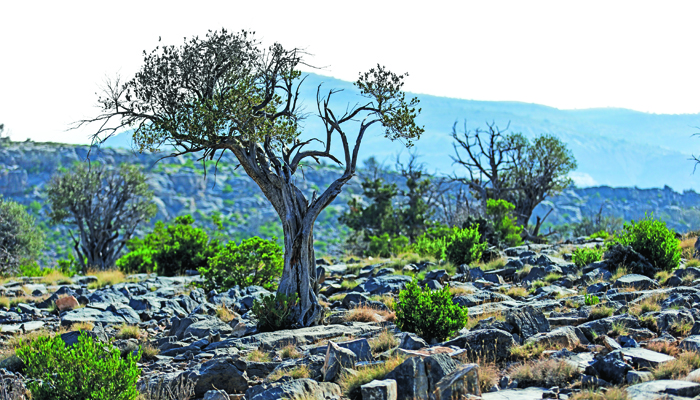
Muscat: Protecting the environment and conserving Oman’s rich biodiversity are among the key objectives under Vision 2040, a senior official at the country’s Environment Authority has said.
Oman recently presented its sixth national report on biodiversity to the Secretariat of the United Nations Convention on Biological Diversity, which looks at what the country has done to preserve and sustain its natural resources.
As part of the convention, signatories are required to submit reports on their biodiversity status every two to three years.
“Vision 2040 addresses the axis of environmental protection and preservation of natural resources by making it one of the government’s priorities,” said Saleh bin Naghmoush Al Saadi, the Director of the Biodiversity Department at the Environment Authority. “We also aim to achieve the Sustainable Development Goals, protect people from the harmful effects of the environment, and effectively manage it to create a safe and prosperous society.
“This pillar also aims to generate potential economic opportunities that will see us benefiting from the environment,” he added. “The strategic and optimal use of natural resources and ensuring their sustainability, so that we can support our national economy, and secure our energy needs, is also part of the Vision’s goals.”
Other targets of sustainable biodiversity under Vision 2040 include ensuring food and water security through renewable resources, advanced technology, and making the best use of Oman’s strategic location and resources, while continuing to protect the environment.
The country aims to achieve a balance between environmental, social, and economic demands, while working within the rules of sustainable development, and the responsible use and investment of natural resources and wealth to set up high added value opportunities.
The sixth national report, which was recently submitted to the UN, contained an analysis of the work conducted in Oman between 2015 and 2020, in cooperation with various government and non-government agencies involved in biodiversity.
These organisations are tasked with biodiversity conservation, and limiting the loss and degradation of biodiversity in accordance with the national efforts taken across various sectors in this regard.
Assessment of a country’s efforts to preserve biodiversity is also done in keeping with 15 global strategic goals, called the Aichi Biodiversity Targets.
“Efforts taken in the Sultanate include the relevant measures and actions taken to implement measures to preserve biodiversity, as well as their effectiveness,” explained Al Saadi. “Also important are the challenges associated with them, and the scientific and technical developments needed to achieve national goals.”
“The third part of this process is an assessment of progress towards each national goal, according to the indicators and activities used to measure each objective,” he added. “National efforts to achieve the goals of the Aichi Biodiversity targets are the fourth section of our report, while the fifth deals with updates on biodiversity, including a presentation on its status, the trends in this area, and the challenges it faces.”
Al Saadi explained that the draft of Oman’s national strategy and biodiversity action plan has been completed in accordance with the global strategic plan from 2011 to 2020, and in accordance with the Aichi goals.
“However, because the convention intends to adopt a new ten-year strategic plan, also called the post-2020 global strategic plan, either during this year or the next, the authority has decided that all national strategies and plans concerned with the environment – including our own directions to develop Oman’s environmental strategy – must be included in one template,” he said.
“A national plan for biodiversity is being prepared,” he added. “Drafted every 10 years, the next national plan will be prepared in line with the framework of the post-2020 global strategic plan for biodiversity.”
The strategy provides the opportunity to incorporate a number of new priorities, including assessing the status and value of biodiversity, identifying and limiting threats to species and ecosystems, arising mainly from human activities, and adopting the traditional approaches among local communities to maintain and sustain biological diversity.
This includes agricultural biodiversity, which will help meet the needs of the population when it comes to food, health care, raw materials, and commercial and industrial materials.
The strategy also plans to reduce and mitigate the effects of global warming as a result of increasing carbon emissions.
Among other priorities are a legal framework to protect biological resources, balance the economic, social and environmental benefits of their use at local, national, and regional levels, and restore habitats and ecosystems.
The EA also aims to raise awareness among the public, conduct surveys to classify species, ecosystems and habitats of interest, and enrich genetic diversity to develop local species of animals. The initial draft of the post-2020 framework will be discussed at the next conference of the parties involved, and has a number of main goals.
Among these include efforts to enhance the integrity of ecosystems so that they increase by at least 20 percent in area, maintain the interconnectedness and integrity of these systems, support health and resilient populations for all species, reduce the extinction rate at least tenfold, reduce the risk of species extinction across all taxonomic groups by 50 per cent, and conserve the genetic diversity of wild and domesticated species, while maintaining at least 22 genetic diversity within all species.
Other goals include assessing nature’s contribution to people, and to conserve or enhance them through conservation and sustainable use, while supporting a global development agenda that benefits everyone.
The framework also focuses on sharing benefits in a fair and equitable manner, with a significant increase in the monetary and non-monetary benefits shared by all. These include biodiversity conservation, sustainable use, and bridging the financial gap to achieve the objectives of the UN Sustainable Vision 2050, which aims to provide sustainable living for all, while respecting the planet.
Oman submitted its first biodiversity report in 1998, after acceding to the UN Convention on Biological Diversity on December 7, 1994, under Royal Decree No 119/94.